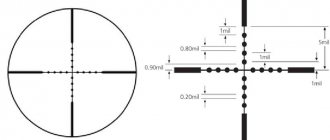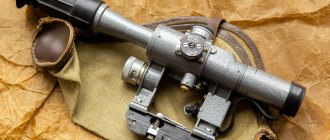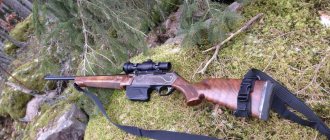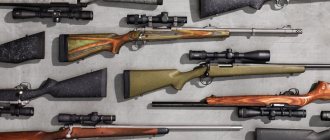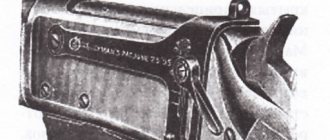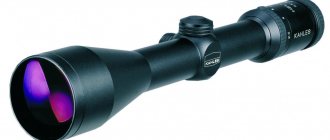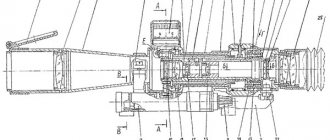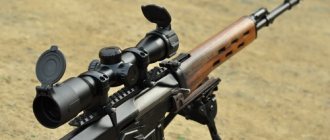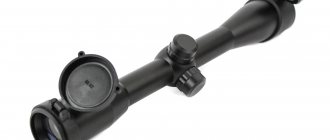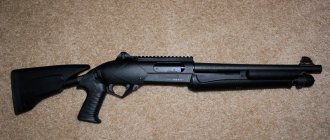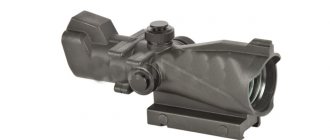A carbine is an improved version of a rifle, characterized by a shortened barrel. It has compact dimensions and light weight, which has made it popular among hunting enthusiasts. It can be used both for long-distance shooting at large animals, and at short distances at small game. In both cases, it becomes necessary to install a sight that will help you see the target. For this weapon, the best option is standard optics, which allows you to increase the accuracy of shots. A significant advantage of the optical device is its proximity, due to which the target becomes visually closer to the shooter, which allows successful hunting even at a distance of 100, 200 or more meters to the object. These devices can be with constant or variable zoom - pancratic (they make it possible to smoothly change the magnification and continuously observe the object). In addition, they differ in their characteristics and parameters, so many, even experienced hunters, find it difficult to determine which optical sight is better and which model to choose for carbines.
Aiming device
Optical sights for a carbine are special devices used to accurately aim at a target when shooting over long distances or in bad weather conditions. They are attached to the weapon using brackets that provide reliable fixation. The advantages of such a device include multiplicity - the ability to bring an object closer. The higher this indicator, the greater the magnification, but the smaller the field of view. Models with low magnification have a wider field of view and are comfortable for hunting constantly moving animals that are at a short distance. In addition to approximation, the main advantage is the ability to keep the image of the target and the aiming mark in the same plane. This allows the shooter not to strain his eyes and not to have to adjust when aiming from the target to the front sight and vice versa. It is this quality that makes such a device one of the fastest sighting systems. It should also be noted that due to the design of such optics and the possibility of magnification, it can be used even by those who have vision problems.
The optical sight, which is mounted on the carbine, consists of the following elements:
- Lens – includes two lenses (some samples have more). It transmits an image of an object upside down. The lens can be made with different diameters and the quality of the image depends on its size. In addition, if the diameter is large, then the field of view is correspondingly larger.
- Wrapping system. Transfers the image that is created in the lens to a straight position.
- The sighting reticle is the sighting device itself. Located in a plane (objective or ocular). Thanks to this, it and the picture of the object are visually located in the same plane, thanks to which the eye sees them equally clearly.
- An eyepiece is a mechanism consisting of several lenses that allows you to view a close object and a reticle.
Important! To accurately fix the eye in the area of full visibility of the device, as well as to eliminate possible glare and light exposure, a special eyecup is often attached over the eyepiece.
- Grid highlighting. Present in some samples and makes it possible to aim more accurately in the dark. More convenient are mechanisms that have the function of adjusting the brightness of the backlight.
- Device for inputting horizontal and vertical corrections. Allows you to zero the weapon and connect the center of the reticle and the exact location of the bullet impact.
- Frame. Necessary to protect all mechanisms of the device from possible shock loads that occur during shooting. Made from durable materials that do not weigh down the structure.
Which reticle should you choose?
Reticles come in a wide variety of types and types. Naturally, they should be selected taking into account the specific features of further application.
Fine Crosschair. The oldest of all types. Initially, just two threads intersecting at right angles. It will give you the opportunity to simply aim at the target. Then everything depends on your knowledge, experience and luck.
Dot (DOT). Dot. Often glowing. It is used primarily in collimator and driven sights. It does not block the visible image, but quickly and immediately catches the eye and stands out in contrast against the background of the target. In other words, where you need to quickly take aim at a suddenly appearing and quickly moving target, the luminous dot is really good. It is also clearly visible in low light conditions.
The so-called “German” ( German ). The lower and side beams of the crosshair are thick, clearly visible, forming a seemingly unclosed letter T. The upper beam and the crosshair itself in the center are either absent or much thinner (so as not to overlap the aiming point). The main benefit of such a reticle is that the thick T is easy to quickly catch the eye even in poor lighting or rush conditions. Variants of the “German” reticle with additional illumination are quite widespread.
Duplex . A kind of development of the German grid type. The upper beam was also made by Tolstoy. The center is also left free (or there is a crosshair made of thin threads, often with additional scale markings). It is often used for hunting, as it is clearly visible against the background of foliage and heterogeneous forest vegetation.
Ballistic (Bullet Drop Compensation, BDC). The lower beam of the crosshair (“at six o’clock”) is marked with a special scale that allows you to adjust the accuracy of hits at different distances, taking into account the drop of the bullet. Allows more accurate shooting at distant targets. Available in many different options.
A little clarification may be needed here. Since a speeding bullet is affected by the Earth's gravity, the bullet never travels simply in a straight line. Over time, its trajectory begins to gradually decrease and eventually the bullet “falls”. The easiest way to account for bullet drop is to aim slightly higher than the desired target so that the bullet hits the right spot regardless of gravity. The marking of the ballistic reticle greatly facilitates this aiming technique, making the result more accurate and predictable. Experienced shooters perform certain calculations taking into account the distance to the target, the type of ammunition, data from a table compiled specifically for the data of the sight and rifle. This allows you to achieve high accuracy when shooting at targets at various (sometimes very significant) ranges.
Horus. Ballistic sighting reticle with markings of horizontal crosshairs as well. Makes it possible to take into account not only the drop of a bullet at long firing distances, but also the horizontal drift of a bullet under the influence of wind. To be used effectively, it requires certain skills. Often used by athletes.
Mil Dot. The crosshairs in this reticle are marked in a very specific way. Highly visible points are marked on the grid so that there is a step of one mil (milliradian, mil) between their centers. This is an angular value. With the ability to use this reticle, the shooter is able to estimate the distance to the target, and also make corrections quite easily.
According to the method of applying the mesh, they are divided into:
- traditional (wire)
- engraved (laser applied to the glass lenses)
The engraved version is more durable and reliable, but also more expensive.
How to measure distance with a Mil Dot reticle?
To estimate distance, you need to know the size of the target. Thus, hunters usually know the average height of the most common game in a given area. For example, the average height of an adult roe deer is 23 cm. You are not looking at a roe deer through the scope, and according to the shackle, its height is 5 mil. Next, use the formula “tabular” height in meters, multiply by a thousand and divide by height in mils: 0.23 * 1000/5 = 46 meters. This will be the desired distance to the target.
Mildot was created for the military, but after it was rightfully highly appreciated by hunters, sights with such a reticle can easily be found on the civilian market.
Ballistic-type reticles, as well as chorus and mildot reticles, are generally not recommended for beginning shooters. Their effective use still requires certain knowledge and skills. However, if you plan on shooting long distances, you'll need to master this science as well.
Weapon
The carbine is a shorter, lighter version of the rifle. In addition, shotgun manufacturers named many of their models with this term. This weapon has its own characteristics that you need to know and take into account in order to understand how to choose the right sight for a carbine.
According to their purpose, these types of rifles are divided into combat rifles, intended for weapons, for example, infantry, hunting and service (for police). Those intended for hunting are divided into two types: semi-automatic, which allow you to make several targeted shots at a moving target, and bolt-action, which are designed to make one accurate shot, differing in different barrel locking mechanisms (mainly a rotary or collet system).
Compared to a rifle, it is lighter in weight and compact in size, which makes its use especially convenient for hunters. Despite the fact that it can be used to shoot at fairly long distances, it is mostly used for hunting from a distance of up to 200 meters. This is due to the fact that if the shot is not accurate enough, the wounded animal begins to run away, and at a long distance it will be much more difficult to find it.
Important! Depending on the type of cartridge, the carbine can fire shots at a distance of up to eight hundred meters.
Other features of this weapon include the following:
- in comparison with a rifle, it has a significantly smaller stock and barrel size;
- a magnifying sight on a carbine is the best choice for a lightweight rifle;
- You can fire several shots from it;
- has a long aiming range and impact force;
- easy to use;
- may have additional devices (for example, a bayonet);
- has an affordable price.
Choosing a sight depending on the type of weapon
In addition to the basic parameters of the sight, when choosing optics you also need to pay attention to the type of weapon. Next, we will talk about which scope to purchase, depending on the type of pneumatics used.
Spring-piston rifles
The peculiarity of rifles is the recoil, which is triggered in both directions - along the trajectory of the bullet, as well as in the opposite direction. For them, it is better to purchase sights with a constant magnification of 4-6x. They will be quite sufficient, because... Spring-piston rifles are entry-level weapons. Budget scopes with variable magnification are also suitable. If you purchase a dovetail type device, be sure to purchase special rings. Russian aircraft do not have fastenings of this type.
Magnum class
Owners of rifles of this class can pay attention to scopes with constant magnification, which can also withstand double recoil. The choice of optics characteristics depends on the purpose of using the weapon. For example, if you plan to practice high-precision shooting skills, it is better to choose high-end sights, for example, from the Hawke Airmax series.
Pre-pumped shotguns
Such a weapon has almost no recoil that destroys the sight, while at the same time it has maximum shot accuracy. Optics with variable magnification from 3-12x and more powerful are perfect for it. Devices with a constant multiplicity will not be as comfortable to use, because... their reticle is located in the second focal plane and this makes it difficult to introduce corrections.
How to choose
The choice of an optical sight, especially for a carbine, must be made based on the following device parameters:
- Multiplicity of the device. When choosing optics based on this characteristic, you should indicate the purpose of its use. If shots will be carried out at short intervals (no more than 60 meters), then samples with a magnification of up to x2-x3 are optimal. They provide a wide view, the ability to quickly aim and shoot at moving objects. Shooting from a long distance at static targets requires a sighting device with high magnification. In this case, shots must be fired from a rest position. You can also choose a universal option - a pancratic device, where the magnification is variable, that is, it can be adjusted to certain conditions and different distances.
- Lens diameter. Its large size guarantees good visibility and high picture quality. It all depends on what time of day the hunt takes place.
Important! For standard, daytime hunting, the diameter should be 22-44 mm. Thus, the picture quality will be stable and it will be possible to benefit from the weight of the device, since devices with a lens with a diameter of 50 mm or more are quite heavy, but these are the samples that should be used when shooting in poor lighting.
- Protection from external factors. In some models, the body of the devices is filled with nitrogen, so the optics do not fog up under any conditions. To prevent damage or water from entering the structure, for example, when hunting from a boat or rain, preference should be given to devices with a waterproof and shock-resistant housing.
- Grid highlighting. Having this feature allows you to see the reticle and target better in low light conditions.
- Mounting method. The strength of the device’s fixation, as well as the stability of shooting, depend on this parameter. Manufacturers offer a variety of fasteners, however, the most common is ring fastening. In addition, today there are a large number of fastening methods for various types of shortened rifles. And to choose the best option, you can consult specialists on this parameter.
Brief conclusions
When choosing “optics” for yourself, for example, a sniper scope, it is advisable to immediately decide on the scope of its tasks. In particular, it is recommended to shoot with a scope with more than 4x magnification using a rest, and only at stationary targets. Rifle sights with less than 4x magnification are useful for firing at moving targets. It should also be remembered that with strong recoil of the weapon there is a risk of getting hit in the eye by the eyepiece.
When choosing optical sights, for example, for a sniper, it is advisable to look through it at a distant object. The image should be clear, sharp, with excellent resolution of details throughout the entire field of view. If the scope is variable multiple, you should make sure that changes in magnification do not cause the crosshair to shift and that a clear image of the target is maintained.
It is advisable to opt for proven models from well-known manufacturers, since optical sights are complex multi-component optical devices. It is impossible to familiarize yourself with most of their technical characteristics without special equipment, for example, to find out resistance to shock overload when fired. When selecting optics, special attention should be paid to the absence of scratches or bubbles in the lenses, as well as dust or other foreign objects inside the sights. Whatever optical device you choose, it is advisable to spare no expense on only the best scopes.
Rating
Sometimes even experienced hunters who know what points to pay attention to find it difficult to choose a good model. To help beginners and experienced hunters alike, here is a quick overview of the best rifle scopes for riflescopes:
- PU 3.5x22. Excellent for short and medium range shooting. It has compact dimensions and light weight - 0.4 kg, making it easy to use. The magnification parameter is X3.5.
PU 3.5x22
- Bering Ace 10x42 (BE55142). The device is made in a shock-resistant case filled with nitrogen, so that the optics do not fog up in any weather conditions, and the device itself is protected from damage. It features high aperture, low weight - 0.635 kg, 10x magnification and lens diameter - 42 mm. All this makes this model an excellent device for hunting at long, medium and short distances in the daytime in all weather conditions.
Bering Ace 10x42
- Software 3-9x42 IR WOLF. An excellent option for approach shooting. It is distinguished by its ability to withstand the recoil of a weapon with a muzzle energy of 7000 J, smooth image magnification from 3 to 9 times, a nitrogen-filled body, compact parameters and a lens diameter of 42 mm. Made from durable aircraft grade aluminum, it is reliably protected from damage.
Software 3-9x42 IR WOLF
- Yukon Jaeger 3-12x56 (23028). A universal option that can withstand recoil of any caliber. Excellent for shots from medium to long distances, even in difficult hunting conditions. Fully protected - has a moisture-resistant and shock-resistant case filled with nitrogen. Lens diameter – 56 mm, weight only 0.68 kg, variable magnification – 3 – 12 times.
Yukon Jaeger scope line
This rating of optical sights will help you choose a model that, according to its parameters, will be most effective for carbines.
Collimator sights
These are systems that use a collimator to construct an image of the aiming mark. So the observer’s pupil does not have to be on the optical axis of the sight. It is enough that it is within the projection of the lens. Such sights are distinguished by accuracy and higher aiming speed - 2-3 times higher than in “sight sights”.
BESTSIGHTG1 – with 4 points
The rating opens with an inexpensive model from China, which can be purchased for only 1,200 rubles in the minimum configuration. The device has a coated lens, as well as 4 types of aiming marks (red and green dots, crosses, circles). The body is sealed and protected from moisture, which allows you to shoot effectively while hunting even during a rainstorm.
View on Aliexpress
Pros:
HAFT500 - 500R from 3000R
